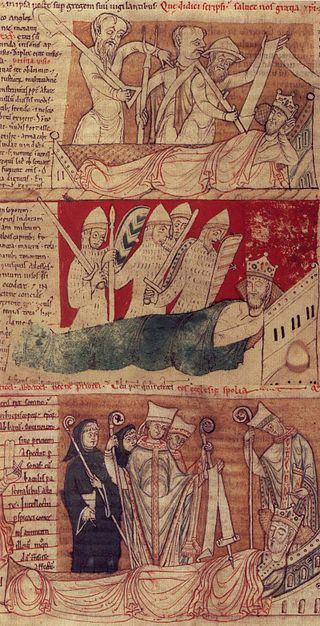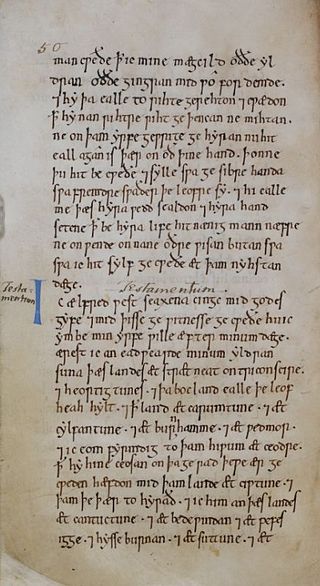Related Research Articles

A chronicle is a historical account of events arranged in chronological order, as in a timeline. Typically, equal weight is given for historically important events and local events, the purpose being the recording of events that occurred, seen from the perspective of the chronicler. A chronicle which traces world history is a universal chronicle. This is in contrast to a narrative or history, in which an author chooses events to interpret and analyze and excludes those the author does not consider important or relevant.

Geoffrey of Monmouth was a Catholic cleric from Monmouth, Wales, and one of the major figures in the development of British historiography and the popularity of tales of King Arthur. He is best known for his chronicle The History of the Kings of Britain which was widely popular in its day, being translated into other languages from its original Latin. It was given historical credence well into the 16th century, but is now considered historically unreliable.

The White Ship was a vessel transporting many nobles, including the heir to the English throne, that sank in the English Channel near the Normandy coast off Barfleur during a trip from France to England on 25 November 1120. Only one of approximately 300 people aboard, a butcher from Rouen, survived.
Æthelweard was an ealdorman and the author of a Latin version of the Anglo-Saxon Chronicle known as the Chronicon Æthelweardi. He was a kinsman of the royal family, being a descendant of the Anglo-Saxon King Æthelred I of Wessex, the elder brother of Alfred the Great.
Florence of Worcester, known in Latin as Florentius, was a monk of Worcester, who played some part in the production of the Chronicon ex chronicis, a Latin world chronicle which begins with the creation and ends in 1140.
Nennius – or Nemnius or Nemnivus – was a Welsh monk of the 9th century. He has traditionally been attributed with the authorship of the Historia Brittonum, based on the prologue affixed to that work. This attribution is widely considered a secondary (10th-century) tradition.

The Battle of Brunanburh was fought in 937 between Æthelstan, King of England, and an alliance of Olaf Guthfrithson, King of Dublin; Constantine II, King of Scotland; and Owain, King of Strathclyde. The battle is sometimes cited as the point of origin for English national identity: historians such as Michael Livingston argue that "the men who fought and died on that field forged a political map of the future that remains, arguably making the Battle of Brunanburh one of the most significant battles in the long history not just of England, but of the whole of the British Isles."
William of Malmesbury was the foremost English historian of the 12th century. He has been ranked among the most talented English historians since Bede. Modern historian C. Warren Hollister described him as "a gifted historical scholar and an omnivorous reader, impressively well versed in the literature of classical, patristic, and earlier medieval times as well as in the writings of his own contemporaries. Indeed William may well have been the most learned man in twelfth-century Western Europe."

Historia regum Britanniae, originally called De gestis Britonum, is a pseudohistorical account of British history, written around 1136 by Geoffrey of Monmouth. It chronicles the lives of the kings of the Britons over the course of two thousand years, beginning with the Trojans founding the British nation and continuing until the Anglo-Saxons assumed control of much of Britain around the 7th century. It is one of the central pieces of the Matter of Britain.

The Angles were a dominant Germanic tribe in the Anglo-Saxon settlement of Britain, and gave their name to the English, England and to the region of East Anglia. Originally from Angeln, present-day Schleswig-Holstein, a legendary list of their kings has been preserved in the heroic poems Widsith and Beowulf, and the Anglo-Saxon Chronicle.

John of Worcester was an English monk and chronicler who worked at Worcester Priory. He is usually held to be the author of the Chronicon ex chronicis.
The Gesta Regum Anglorum, originally titled De Gestis Regum Anglorum and also anglicized as The Chronicles or The History of the Kings of England, is an early-12th-century history of the kings of England by William of Malmesbury. It is a companion work of his Gesta Pontificum Anglorum and was followed by his Historia Novella, which continued its account for several more years. The portions of the work concerning the First Crusade were derived from Gesta Francorum Iherusalem peregrinantium, a chronicle by Fulcher of Chartres.

Æthelweard was the younger son of King Alfred the Great and Ealhswith.
Brenhinoedd y Saeson is the medieval title of a Middle Welsh annalistic chronicle. The name means 'the kings of the English'.
The Historia Regum is a historical compilation attributed to Symeon of Durham, which presents material going from the death of Bede until 1129. It survives only in one manuscript compiled in Yorkshire in the mid-to-late 12th century, though the material is earlier. It is an often-used source for medieval English and Northumbrian history. The first five sections are now attributed to Byrhtferth of Ramsey.

The Liber Eliensis is a 12th-century English chronicle and history, written in Latin. Composed in three books, it was written at Ely Abbey on the island of Ely in the fenlands of eastern Cambridgeshire. Ely Abbey became the cathedral of a newly formed bishopric in 1109. Traditionally the author of the anonymous work has been given as Richard or Thomas, two monks at Ely, one of whom, Richard, has been identified with an official of the monastery, but some historians hold that neither Richard nor Thomas was the author.
The Historia Ecclesie Abbendonensis or History of the Church of Abingdon was a medieval chronicle written at Abingdon Abbey in England in the 12th century. The Abbey was historically in the county of Berkshire, but since 1974 has been in the county of Oxfordshire.
The Gesta Pontificum Anglorum, originally known as De Gestis Pontificum Anglorum and sometimes anglicized as The History or The Chronicle of the English Bishops, is an ecclesiastical history of England written by William of Malmesbury in the early 12th century. It covers the period from the arrival of St Augustine in AD 597 until the time it was written. Work on it was begun before Matilda's death in 1118 and the first version of the work was completed in about 1125. William drew upon extensive research, first-hand experience and a number of sources to produce the work. It is unusual for a medieval work of history, even compared to William's other works, in that its contents are so logically structured. The History of the English Bishops is one of the most important sources regarding the ecclesiastical history of England for the period after the death of Bede.

Deruvian, also known by several other names including Damian, was a possibly legendary 2nd-century bishop and saint, said to have been sent by the pope to answer King Lucius's request for baptism and conversion to Christianity. Together with his companion St Fagan, he was sometimes reckoned as the apostle of Britain. King Lucius's letter may represent earlier traditions but does not appear in surviving sources before the 6th century; the names of the bishops sent to him does not appear in sources older than the early 12th century, when their story was used to support the independence of the bishops of St Davids in Wales and the antiquity of the Glastonbury Abbey in England. The story became widely known following its appearance in Geoffrey of Monmouth's History of the Kings of Britain. This was influential for centuries and its account of SS Fagan and Deruvian was used during the English Reformation to support the claims of both the Catholics and Protestants. Christianity was well-established in Roman Britain by the third century. Some scholars therefore argue the stories preserve a more modest account of the conversion of a Romano-British chieftain, possibly by Roman emissaries by these names.
References
- ↑ Antonia Gransden, Historical Writing in England: c. 500 to c. 1307 (London and Ithaca, 1996) p. 219
- ↑ Beryl Smalley, Historians in the Middle Ages (London and New York, 1996) p. 113
- ↑ William of Malmesbury, Gesta pontificum Anglorum , ed. N.E.S.A. Hamilton (RS;1870)
- ↑ Antonia Gransden, Historical Writing in England: c. 500 to c. 1307 (1996)
- ↑ Charles F. Briggs, "History, Story, and Community: Representing the Past", in ed. Sarah Foot and Chase F. Robinson, eds., The Oxford History of Historical Writing: Volume 2: 400-1400 (2012) 2: 391.
- ↑ Michael Swanton, The Anglo-Saxon Chronicle (1998).
- ↑ John Jolliffe, Froissart's Chronicles (Faber & Faber, 2012
- ↑ "Latin Chroniclers from the Eleventh to the Thirteenth Centuries: England and Normandy" from The Cambridge History of English and American Literature (1907–1921).
- ↑ Nancy Partner, "Henry of Huntingdon: Clerical Celibacy and the Writing of History." Church History 42#04 (1973): 467-475. online
- ↑ William of Malmesbury, Gesta regum, prologue.
- ↑ Henry of Huntingdon, Historia Anglorum, 4.11
- ↑ Antonia Gransden, Historical Writing in England: c. 500 to c. 1307 (1996)
- ↑ William of Newburgh, History of English Affairs, Book I, preface
- ↑ John Edward Lloyd, "Geoffrey of Monmouth", English Historical Review (1942) 57#228 pp. 460–468 in JSTOR